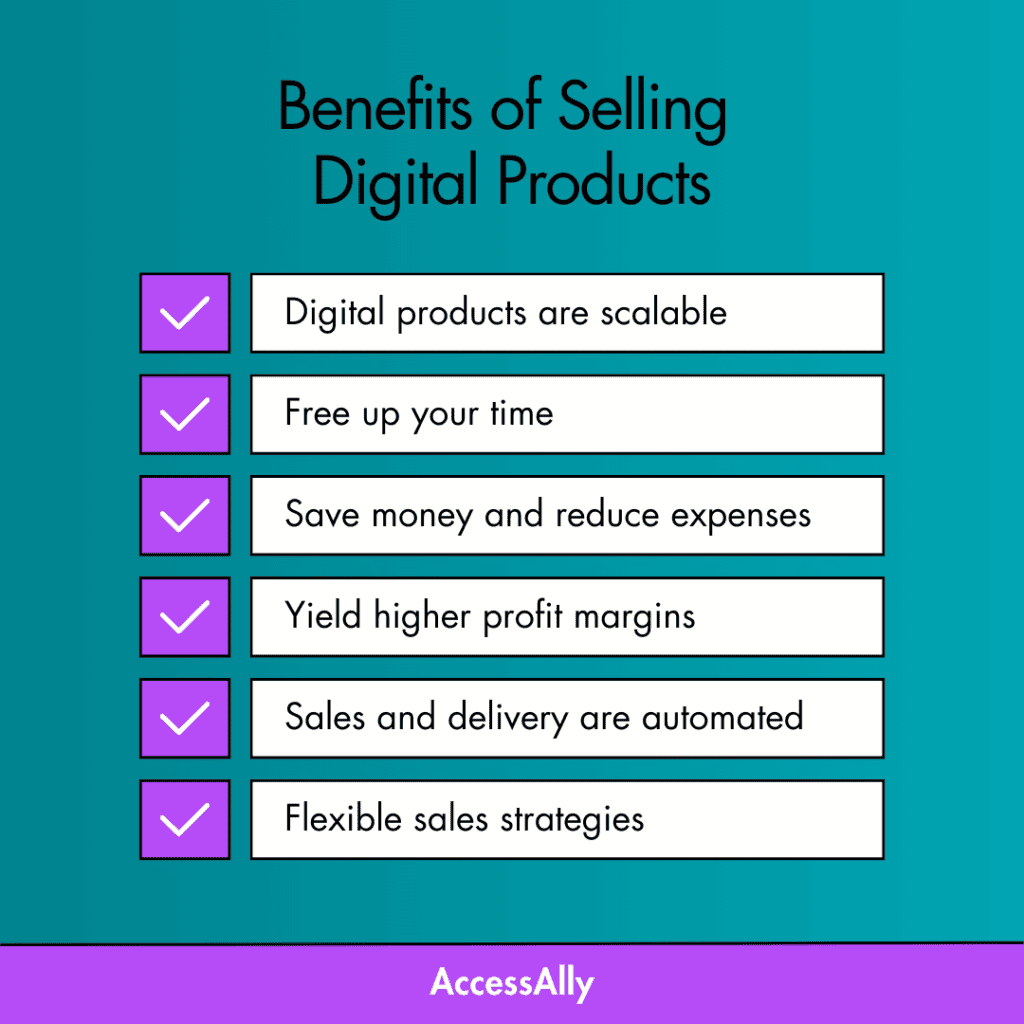A digital product is any item that can be purchased and consumed online, such as eBooks, online courses, software, and digital art. This market is booming, with global digital sales projected to exceed $300 billion by 2025, driven by the growing preference for convenience and instant access.
Selling digital products can offer numerous benefits to a business: no inventory or shipping costs, infinite scalability, and the potential for passive income, as products can be sold around the clock with minimal ongoing effort.
However, there are challenges, such as competing with free content and protecting against piracy. Succeeding with digital products requires offering unique, high-quality products and effective marketing. With countless opportunities available, finding the right niche aligned with your expertise and passions is crucial. In this blog post, we’ll explore the ten best digital products to sell, and help you identify the perfect fit for your business.
Why Decide to Sell Digital Products?
Before we dive into what types of digital products to sell, let’s talk about why you should consider adding digital products to your business.


Digital Products Are Scalable
When you sell digital products, your sales potential is unlimited.
Digital products are infinitely scalable and don’t require much additional effort on your end to deliver. You may need to invest in a premium, quality website hosting solution to ensure uptime for your site and access for your customers.
Free up Your Time
A major benefit of selling digital products is the amount of time it saves when it comes to delivering your offers.
Not only are you able to provide your customers with a sense of instant gratification when they purchase one of your offers, but you also don’t have to deal with the logistics of managing, sourcing, and delivering inventory.
However, we have seen some very successful memberships that include a subscription box paired with their online access. Here’s a look into our subscription box case study.
Save Money and Reduce Expenses
Going digital will save you tons when it comes to costs associated with in-person or physical products.
If you sell physical products you’re responsible for the cost of the product itself before markup, storage costs for your inventory, and shipping costs.
If you run in-person events or courses you’ll likely have costs associated with renting the location for the event and any personnel costs required for running and managing the events. You’ll also need to account for any costs you may acquire if you need to provide supplies or food and drinks for your attendees.
The expenses start to add up quickly. Selling digital programs is a great way to avoid these costs altogether and save money.
Digital Products Yield Higher Profit Margins
When you’re selling digital products compared to physical ones you’re able to sell more with fewer expenses. As a result, you’ll notice higher profit margins on your sales.
Plus, you may even be able to charge more due to the ease of convenience for your customers when it comes to receiving and using the product they purchased.
Digital Product Sales & Delivery are Automated
One of our favorite benefits of selling digital products is the automation involved. From sale to delivery, the entire process can be set up and left to run on its own for the lifespan of your offer.
There are so many content delivery platforms and plugins, as well as sales tools that make this process so easy for you to implement.
While the time investment to get everything set up just the way you want it may seem like a lot when you’re first setting things up, once it’s done it’s done. We can all appreciate that.
Waking up to new sales each day is so rewarding, and knowing your customers received everything they purchased and can start to experience what they purchased right away is so rewarding, for you and them! All thanks to the power of automation.
Automating this process frees you up to focus on activities that will help grow your business and less on running it.
Flexible Sales Strategies
Having the flexibility to pivot your sales strategies when something isn’t working or you have a new idea to test is a major benefit of selling digital products online.
Not only can you create and sell new digital products or extensions of existing products, but you might decide to bundle some of your offers if you’re selling digital downloads into a membership where users get access to the entire library of downloads.
If you’re selling online courses you can sell them individually or as part of a membership platform. The sky’s the limit and as long as your platform for selling digital content can support your vision you’re only limited by your imagination.
Top 10 Digital Products to Sell
Now let’s look at some of the best digital products your business might decide to sell. For each option, we’ll explain what it is, discuss some of the pros and cons, and provide examples, when appropriate.
1. Online Courses
Online courses are one of the best digital products to sell because people are always looking to improve their skills and knowledge. With more people spending time at home, there’s a growing demand for convenient, self-paced learning options. This makes online courses an excellent opportunity to reach a wide audience eager to learn new things.
Creating and selling online courses is also a fantastic way to generate passive income. Once you develop the course content and set it up, it can continue to sell without requiring much ongoing effort from you. However, choosing the right tool to create and sell your course is crucial. You can use standalone platforms or WordPress plugins.
For more information, visit AccessAlly’s comparison of online course platforms here. For detailed guidance on how to sell courses online, check out this blog post.
Pros of Selling Online Courses
- Scalability: Sell the course to unlimited students without additional production costs.
- Passive Income: Earn money continuously with minimal ongoing effort.
- Flexibility: Create courses on any topic you are passionate about.
- Global Reach: Access a worldwide audience.
- Low Overhead: No need for physical inventory or shipping.
Cons of Selling Online Courses
- Competition: High competition with many free and paid courses available.
- Marketing Effort: Requires effective marketing to stand out and attract students.
- Initial Time Investment: Creating quality content can be time-consuming.
- Technical Challenges: Requires knowledge of or investment in suitable platforms and tools.
- Updates and Maintenance: Courses may need regular updates to remain relevant and accurate.
2. Memberships
Memberships are subscription-based digital products that grant members access to exclusive content, services, or communities on an ongoing basis. They are one of the hottest digital products to sell online because they provide consistent, recurring revenue and foster a loyal customer base. Unlike online courses, which are typically one-time purchases, memberships offer continuous value, helping you generate passive income month after month. To learn more about the differences between online courses and membership sites, visit this comparison article.
If you’re ready to create a membership site, we’ve got you covered with a comprehensive guide available here. To start selling memberships, you’ll need a robust platform to manage subscriptions, deliver content, and engage your community.
Pros of Selling Memberships
- Recurring Revenue: Steady, predictable income from subscriptions.
- Customer Loyalty: Builds a dedicated community around your brand.
- Scalability: Easily add new content and services to retain and attract members.
- Flexibility: Offer various membership tiers and pricing options.
- Continuous Engagement: Foster ongoing interaction and feedback from members.
Cons of Selling Memberships
- Content Demands: Requires regular updates and new content to keep members engaged.
- Higher Initial Setup: More complex setup compared to one-time digital products.
- Member Retention: Needs strategies to reduce churn and retain members.
- Technical Challenges: Involves managing subscriptions and secure content delivery.
- Marketing Effort: Continuous marketing is necessary to attract and retain members.
3. E-Books
If you have a passion for writing and expertise in a particular area, creating and selling an e-book can be one of the best digital products to offer. E-books allow you to share your knowledge, tell compelling stories, or provide valuable insights to a broad audience. They are relatively easy to produce and distribute, making them a great entry point for digital product sales.
To sell an e-book, you need to write and format your content, create an appealing cover, and choose a platform for distribution. E-books can be sold on your website, Amazon Kindle Direct Publishing, Apple Books, or other digital marketplaces. Popular e-book ideas include how-to guides, self-help books, industry-specific advice, and fiction or non-fiction works.
Pros of Selling E-Books
- Low Production Costs: Minimal expenses for writing, editing, and design.
- Ease of Distribution: Instant delivery through multiple online platforms.
- Passive Income: Continue to earn from each sale after the initial launch.
- Brand Building: Establishes you as an authority in your niche.
- Accessibility: Reaches a global audience without physical limitations.
Cons of Selling E-Books
- Market Saturation: High competition with numerous e-books available.
- Pricing Pressure: Often sold at lower prices, impacting profit margins.
- Marketing Effort: Requires significant marketing to stand out.
- Content Piracy: Risk of unauthorized distribution and copying.
- Initial Time Investment: Writing and formatting can be time-consuming.
4. Templates
Templates are pre-designed documents or tools that can be customized for various purposes. Popular types of templates to sell online include motivation letters and resumes, newsletter templates, Excel sheets, social media posts, business plans, and presentation slides. These templates save time and effort for users, making them highly valuable.
Selling templates is one of the best digital products because they address specific needs and offer immediate value. Templates can be created once and sold multiple times, providing a scalable source of passive income. Their versatility and wide applicability make them appealing to a broad audience, from job seekers and business owners to marketers and educators.
Template Ideas to Sell
- Resume and cover letter templates
- Newsletter templates
- Excel budget and financial planning sheets
- Social media content calendars
- Business plan templates
- PowerPoint or Keynote presentation slides
- Website and blog templates
- Graphic design templates (e.g., Canva templates)
- Email marketing templates
Pros of Selling Templates
- High Demand: Templates are needed across various industries and purposes.
- Scalability: Create once, sell many times.
- Passive Income: Generate revenue with minimal ongoing effort.
- Ease of Production: Often quicker to create compared to other digital products.
- Value Addition: Helps users save time and increase efficiency.
Cons of Selling Templates
- Customization Limits: May require adjustments to meet specific user needs.
- Competition: Many free and paid templates available.
- Piracy Risk: Potential for unauthorized distribution.
- Ongoing Updates: May need to update templates to stay relevant.
- Initial Design Effort: Requires design skills and time investment upfront.
5. Photography
Photography can be one of the best digital products to sell because high-quality images are always in demand for websites, marketing materials, social media, and more. If you have a talent for capturing stunning photos, you can turn this skill into a profitable business by selling your work online.
To sell photos online, you’ll need a good camera, editing software, and a platform to showcase and sell your images. You can sell your photos on stock photo sites like Shutterstock, Adobe Stock, and Getty Images, or create your own website to sell them individually, in bundles, or through a subscription-based membership site.
Pros of Selling Photos
- High Demand: Constant need for fresh, high-quality images across various industries.
- Scalability: Sell the same photo multiple times.
- Passive Income: Earn ongoing revenue from your photo library.
- Creative Outlet: Turn your passion for photography into a business.
- Flexible Pricing: Sell individual images, bundles, or subscription access.
Cons of Selling Photos
- High Competition: Many photographers and vast collections of stock photos available.
- Initial Investment: Requires good camera equipment and editing software.
- Quality Standards: High expectations for image quality and resolution.
- Marketing Effort: Need effective marketing to stand out and attract buyers.
- Piracy Risk: Potential for unauthorized use and distribution of your photos.
6. Graphic Design
In the graphic design domain, you can sell a wide range of downloadable visual components that people can use in their presentations, videos, marketing materials, websites, and more. These include icons, logos, illustrations, infographics, social media graphics, templates, fonts, and vector art. Unlike custom orders, these pre-made design elements are available for instant download, offering convenience and immediate utility to buyers.
Selling graphic design elements is a great product choice because it caters to the continuous need for visually appealing content in various industries. Businesses, marketers, educators, and content creators constantly seek high-quality graphics to enhance their projects. By offering downloadable design elements, you can reach a broad audience and generate passive income.
Examples of Graphic Design Elements to Sell
- Icons and logos
- Infographics and charts
- Social media post templates
- Presentation slide designs
- Website and blog templates
- Vector illustrations
- Custom fonts and typography
- Animated graphics and GIFs
Pros of Selling Graphic Design Elements
- High Demand: Continuous need for fresh, high-quality visual content.
- Scalability: Sell the same design multiple times.
- Passive Income: Earn ongoing revenue with minimal ongoing effort.
- Creative Expression: Monetize your design skills and creativity.
- Wide Reach: Appeal to a diverse audience across different industries.
Cons of Selling Graphic Design Elements
- High Competition: Many designers and premade graphics available.
- Initial Time Investment: Requires significant time to create high-quality designs.
- Piracy Risk: Potential for unauthorized use and distribution.
- Market Saturation: Must constantly innovate to stand out.
- Pricing Pressure: Need to balance competitive pricing with profit margins.
7. Guides
Guides are “how-to” manuals that provide step-by-step instructions to help readers accomplish specific tasks or gain knowledge in a particular area. They are good digital products to sell because they offer practical value and can address a wide range of topics, making them appealing to a diverse audience. Guides can be sold as standalone products or bundled with other offerings to enhance their value.
A guide can include various elements such as detailed instructions, visuals (e.g., images, charts, diagrams), expert advice, tools, and resource lists. These components help make the content more engaging and easier to follow. Examples of guides that can be created include a tourist guide, a guide to using a specific product, a fitness guide, a DIY project manual, and a small business startup guide.
Pros of Selling Guides
- High Demand: People constantly seek information and solutions to specific problems.
- Value Addition: Provides practical, actionable advice and instructions.
- Scalability: Can be sold to an unlimited number of customers.
- Passive Income: Generate ongoing revenue after the initial creation.
- Flexibility: Can cover a wide range of topics and industries.
Cons of Selling Guides
- Time-Consuming: Requires significant time and effort to research and create high-quality content.
- Competition: Many free and paid guides available online.
- Updates Needed: May require regular updates to remain relevant and accurate.
- Marketing Effort: Needs effective marketing to reach and attract the target audience.
- Piracy Risk: Potential for unauthorized sharing and distribution.
8. Coaching & Consulting
Even though coaching and consulting are not strictly downloadable products, they are still digital products you can sell online. Offering coaching and consulting services can be highly profitable because they provide personalized, expert guidance tailored to the specific needs of clients. With the increasing acceptance of virtual interactions, these services can be delivered via video calls, webinars, and email, reaching a global audience.
Coaching and consulting services are in high demand across various industries. For example, business coaching, life coaching, health and wellness consulting, career coaching, and financial consulting are all popular options. These services help individuals and businesses achieve their goals more effectively and efficiently.
For more insights on scaling a coaching business, check out this blog post.
Pros of Selling Coaching and Consulting
- High Demand: Personalized services are always sought after.
- High Profit Margins: Can charge premium rates for expertise and personalized attention.
- Global Reach: Offer services to clients worldwide via online platforms.
- Scalability: Opportunities to scale through group sessions, courses, and digital resources.
- Value Addition: Significant impact on clients’ personal and professional growth.
Cons of Selling Coaching and Consulting
- Time-Intensive: Requires a significant time commitment per client.
- Limited Scalability: One-on-one sessions can limit the number of clients you can serve.
- Marketing Effort: Needs effective marketing to build a client base.
- Client Retention: Maintaining long-term client relationships can be challenging.
- High Expectations: Clients expect high levels of expertise and results.
9. Mobile Apps
Mobile apps are highly sought-after digital products due to the widespread use of smartphones and tablets. They offer unique functionalities and solutions to users, ranging from productivity tools and entertainment apps to fitness trackers and educational resources. Selling mobile apps can be lucrative as they can be priced as one-time purchases or through subscriptions, generating continuous revenue.
Mobile apps can be sold through app marketplaces such as the Apple App Store and Google Play Store. Additionally, software products, which encompass a broader range including desktop applications and web-based software, are also profitable digital products to sell. These products cater to specific needs such as accounting software, graphic design tools, project management platforms, and more.
Pros of Selling Mobile Apps
- High Demand: Millions of smartphone users actively seek new apps.
- Scalability: Potential to reach a global audience instantly.
- Revenue Streams: Opportunities for one-time purchases or recurring subscriptions.
- Innovation: Constant updates and new features can attract loyal users.
- Monetization Options: Can integrate ads, in-app purchases, or premium versions.
Cons of Selling Mobile Apps
- Development Costs: Initial investment in development and testing.
- Competition: Saturated app markets with numerous alternatives.
- App Store Approval: Must meet guidelines and undergo approval processes.
- User Acquisition: Requires effective marketing and user acquisition strategies.
- Support and Maintenance: Ongoing updates and customer support are necessary.
10. Music & Audio
Selling music and audio can be highly profitable due to the widespread consumption of digital media and the increasing demand for personalized and immersive audio experiences. Musicians, sound engineers, and content creators can monetize their work by selling various types of audio content online.
Music and audio can be sold on digital platforms such as iTunes, Spotify, Bandcamp, and Amazon Music, as well as through personal websites and online marketplaces. Examples of what can be sold include original songs, sound effects, background music for videos, meditation tracks, audiobooks, podcasts, and audio courses.
Podcasts are also popular digital products that can be monetized through subscriptions, sponsorships, or donations, making them a versatile addition to your digital product offerings.
Pros of Selling Music & Audio
- Wide Audience Reach: Access global audiences through digital platforms.
- Diverse Revenue Streams: Earn from downloads, streaming, subscriptions, and licensing.
- Creative Freedom: Showcase original compositions and audio creations.
- Passive Income: Continuously earn royalties from ongoing sales and streams.
- Community Engagement: Build a loyal fan base and connect with listeners.
Cons of Selling Music & Audio
- High Competition: Crowded market with numerous artists and creators.
- Royalty Payment Delays: Payments from streaming platforms can be delayed and unpredictable.
- Copyright Issues: Risk of unauthorized use or piracy of your audio content.
- Production Costs: Initial investment in recording equipment and software.
- Marketing Effort: Requires effective promotion to stand out in a saturated market.
Where to Sell Digital Products?
The platform you choose to sell your digital products depends largely on the type of product and your business goals. Different types of digital products may thrive on specific channels tailored to their audience and format. For instance, e-books and digital downloads are commonly sold on established marketplaces like Etsy and Amazon due to their wide reach and built-in customer base. Online courses, on the other hand, can be successfully marketed through dedicated platforms such as Masterclass, Udemy, and Skillshare, which specialize in educational content.
Selling digital products on your own website offers advantages in terms of control over branding, customer relationships, and profit margins. It allows for more direct customer interaction and the potential to build a loyal following. Additionally, mobile apps and software products may benefit from distribution through app stores like the Apple App Store and Google Play Store, leveraging their global reach and built-in payment systems.
Regardless of where you choose to sell, developing a robust marketing strategy is crucial. Effective marketing ensures your digital products reach your target audience, stand out amidst competition, and drive sales. Utilizing social media, email marketing, content marketing, and SEO can all contribute to the success of your digital product sales strategy.
Selling digital products offers plenty of opportunities for entrepreneurs and creators alike. From e-books and online courses to mobile apps and music downloads, the range of products you can sell online is vast and diverse. These products not only cater to evolving consumer needs but also allow for scalable business models and passive income streams.
While each type of digital product presents its own set of challenges, strategic planning and effective marketing can help mitigate these risks and ensure your success. Whether you choose to sell through established marketplaces, your own website, or specialized platforms, understanding your target audience and delivering valuable content remains key to success.




